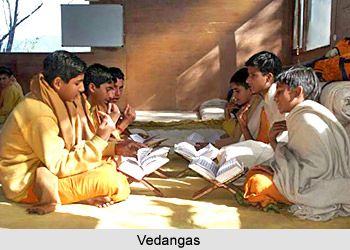 Chandas refer to the meter of Vedic poetry. It is considered the third limb in the Veda. It deals with the types of metres used for constructing various Vedic hymns. It is probably composed in the 5th and 6th century BC. Vedic meter is always measured by the number of syllables whereas the metrical unit of verse is the pada. It is generally of eight, eleven, or twelve syllables; these are termed gayatri, tristubh and jagati respectively.
Chandas refer to the meter of Vedic poetry. It is considered the third limb in the Veda. It deals with the types of metres used for constructing various Vedic hymns. It is probably composed in the 5th and 6th century BC. Vedic meter is always measured by the number of syllables whereas the metrical unit of verse is the pada. It is generally of eight, eleven, or twelve syllables; these are termed gayatri, tristubh and jagati respectively.
Syllables are divided into two categories, Guru and Laghu. A series of Guru-Laghu sequence of a particular length is called a metre. Rig and Sama vedas are written in the form of verses and Yajur Veda has prose and poetry. A sloka or veda mantra is generally a quartet with four quarters or paada. There are various metres in which the Vedic mantras are composed; they are anushtup (8 syllables), brihati (9), pankti (10), trishtup (11), ushnik (4 paadas of 7 syllables each). The well known Gayatri Mantra has three paadas of 8 syllables each; the meter itself is known as gayatri since it has 24 syllables. Chandas helps us to ensure the form of the Mantra and also determines its usage. Each mantra is dedicated to a Devata and has a specific chanda devoted to it. It also holds the name of the Rishi who created it. It is for this reason that we touch our head, nose heart while reciting it. It is a sign of reverence.
The knowledge of Chandas helps in the composition of Smriti literature. It has helped in the emergence of Indian classical music and much Sanskrit poetry.
This article is a stub. You can enrich by adding more information to it. Send your Write Up to content@indianetzone.com













